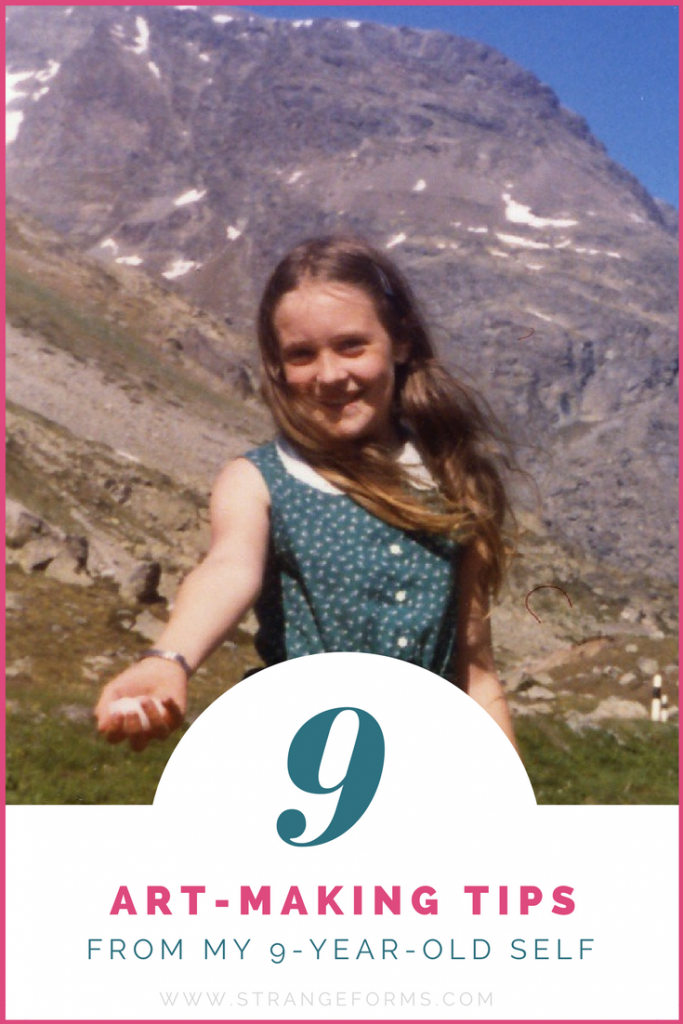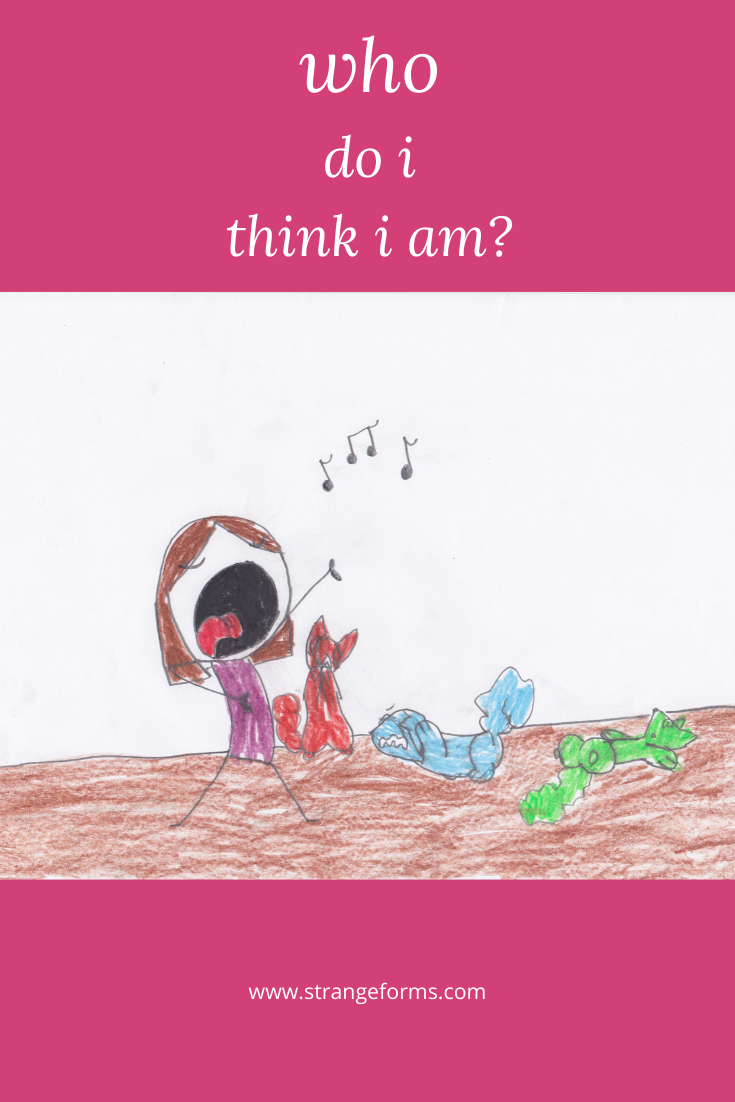Hey, it’s my birthday!
Now that I’m officially une femme d’un certain âge (45 – whoop!), birthdays have a tendency to make me look back.
Today, something put me in mind of family holidays when I was a kid.
Once school ended, my parents would pile everybody into the car, stuff suitcases and bags into every crevice, and drive all the way from Dublin to France and Italy (via Great Britain, where we’d stay with my aunt and uncle in London).
Here’s me, stretching my legs on one of those long, long journeys, and showing off the most delightful treasure: some snow that had lingered on this alpine pass. Snow! In July! Could life get any better?
I’m nine in this picture.
I was a busy child, writing my stories, making my craft projects, press-ganging small relatives into my all-singing-all-dancing theatrical productions.
It was simpler back then. The blank page held no terror: I just grabbed hold of a passing idea and hung on tight. The raw materials for anything I wanted to sew or knit or crochet could be found among my great-aunt’s fabric remnants, my grandmother’s yarn ends.
Playing (and, by extension, plays) flowed naturally, without anguish or hesitation. Creatively speaking, I often didn’t know where I was going, but it didn’t matter because I was having such a good time getting there.
My nine-year-old self would have been pleased, I think, to know how passionate I still am about all these creative pursuits more than three decades on.
My general approach to art-making feels a bit different now from hers, though. I’ve been wondering what advice she’d give me – what have I forgotten in the intervening years?
Here are, oh, let’s make it nine things she might say … or at least, she might if she spoke in the idiom of a 45-year-old, 21st-century mother of two.
1. Experiment
Take an idea and run with it – try things out.
You don’t have to know how the story ends before you begin.
Make a sampler piece. Doodle. Improvise.
Work small or dive straight into a full-scale project: it doesn’t matter.
Don’t be afraid that it’ll all go wrong. If it all goes wrong, you can probably fix it anyway, or turn it into something else.
2. Use what you have
Just because you’ve used something before doesn’t mean you’re finished with it. There’s no need to start completely from scratch if you don’t want to.
What did those characters do next?
Could that scene you cut grow into a story of its own?
What’s worth photographing on your way to work?
What would that paint look like on this surface?
What does this blue silk need to set it off?
And while we’re on the subject of tangible art, please don’t forget that you possess an almighty stash, some of which has been around since before you and I were born, and I’m not saying “don’t buy more until you’ve used all this up” (my god – you actually have money for supplies?!) but maybe just … think about it first. For any given project, you probably already have something that can be used.
3. The right tool may make things easier, but the wrong tool can often do the trick
This is related to “use what you have”, but it’s more about inhibitions.
Now that you’re a grown-up, you know so much more about what’s theoretically available that it’s easy to fall into thinking that there’s no point in starting until you have the perfect setup.
But you don’t need that special software to write your novel.
The mental tic that says, “I don’t have any coilless safety pins – I can’t possibly think about making a quilt!”? Not helpful.
Cobble something together. Start on the back of an envelope. You’ll be fine.
4. Produce lots
Make art, then make more art.
Trust the process – and trust that creative failure is as much part of the journey as creative success.
Don’t be afraid of wasting time and resources if a project doesn’t work out how you planned. The experience is always valuable.
And for god’s sake, stop worrying about making “too much”.
Make what you feel like making. That way, you’ll get better at what you love, and you’ll have more beautiful things to send out into the world. Win.
5. No need to shake the universe with every project
Simple is good too.
The old stories still pack a punch. Sometimes a small song is enough. Traditional designs survive because they have a quality that endures.
The well made pieces that you enjoy every day will bring you at least as much pleasure in the long term as the bedizened creations that see action only rarely.
6. Capture ideas
Get back into the habit of sketching designs, noting scraps of dialogue, copying down patterns that strike you, building worlds, tracing and doodling and planning.
As well as your trusty notebook, you carry a camera these days – use it!
You don’t need to do something with every one of these ideas, but catching them as they whoosh by you can only be a good thing.
7. Go with what YOU find beautiful and satisfying
Don’t worry about fashions and trends and what people will think.
If you make art that causes your pulse to quicken and a wide grin to settle on your face whenever you encounter it, all kinds of good will ensue.
Aim to have as much beauty in your life as will fit – I mean real beauty, the stuff that makes you feel alive and aligned.
8. There’s no moral obligation to finish
I think you probably still have projects kicking around that I abandoned in the early 1980s.
You know what? That’s fine.
Keep them if you want, or get rid of them, or repurpose them, but whatever you do, don’t feel a shred of guilt.
The obligation to finish everything you start is a real creativity-killer. Don’t yield to it.
9. This stuff is important!
What art-making means for you – all that complex edifice of memories and skills and emotions – has genuine value in your life.
Don’t downplay it. Give it the space it needs, and allow it to nourish and sustain you.
It’s about maximising joy.
You know that’s your number 1 priority, right?
Right.

